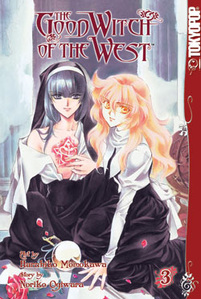Review
by Casey Brienza,The Good Witch of the West
GN 3-4
| Synopsis: |  |
||
Firiel's deceased mother Edilene was actually one of the Star Queen's daughters…which means that Firiel herself is actually, like her newfound friend Adale, a Queen-in-Waiting! The country bumpkin hailing from Sera Field is anything but prepared to cope with the sudden improvement to her social class, however, so the Roland family enrolls her at Taurus Academy, where the daughters of the elite learn the ways of power. Unfortunately, she soon learns that the Academy is a pit of vipers and that no one is going to be able to protect her from the machinations of the Student Council. In the end, though, it is decided that she should forego school and take up her place in the court of Hieraglion. It's time to play with the big boys—and girls! |
|||
| Review: | |||
Noriko Ogiwara's The Good Witch of the West series of novels just gets better and better with age…and so, apparently, does its manga adaptation by Haruhiko Momokawa. Having taken their leave, presumably permanently, from the tropes of classic children's literature found in early chapters, the third and fourth volumes explore themes pertinent to adolescence. And although said themes are well-worn pit stops in the world of Japanese manga, Momokawa executes Ogiwara's original fantasy tale so exquisitely in every conceivable respect that you will be too out of breath to notice. Volume three is a variation of the girls' academy subplot where a refined atmosphere conceals horrid injustice. The bed or roses is, as it were, also a pit of vipers. Although the Taurus Academy bylaws insist that there by no discrimination on the basis of rank, daughters of the nobility obsessively work to weed out the commoners from their midst, watching each other with eyes like hawks for the subtlest of social missteps. Naturally, Firiel finds herself immediately outcast, and at one point someone even tries to push her off of a high balcony. An innocent dies in her stead, and Firiel realizes that she is going to have to learn to defend herself. Not even Rune, who appears in drag as “Runette” to watch over her, is going to be able to do anything. And so, Firiel, under the tutelage of the stoic Igraine, takes up fencing. In the end, though, it proves to be Adale who comes to the rescue, exposing the machinations of her elder sister Leandra, who has, as a small part of her sinister agenda, been egging on the Student Council in their mistreatment of Firiel. Unfortunately, Leandra has poisoned the academic experience for Firiel, so the Roland family decides to allow Firiel to accompany Adale to the court of Hieraglion without delay—out of the frying pan and into the fire. All eyes are on Firiel, and the noble Eusis rushes to her side to deflect suspicion. A burgeoning relationship between him and Firiel develops, even though she is still very much attached to her childhood companion Rune. Whom will she choose? (This is a rhetorical question; the ultimate answer should be obvious enough.) Volume four focuses on a hearty helping of dense political intrigue as we learn more about the ruthless Leandra and her ally of convenience Duke Riez. The duke, as it turns out, is in charge of the shadow group that tortured Rune…and, bitter that his mother is Queen while he, a male, cannot inherit the throne, also intends to undermine the Star Queen selection process and become ruler himself. Little does he suspect that Rune will catch up to him first! These two volumes boast dramatically improved artwork. Momokawa has gradually abandoned his earlier vapid, cutesy style so that by the end of volume four, character designs are attractively elegant and angular. The shift from moé to shoujo fantasy is pure revelation. Firiel's eyes, for example, look progressively less Osamu Tezuka and progressively more Yun Kouga. Backgrounds are kept to an absolute minimum, and you will be too busy drooling over the flowing locks and billowing ballgowns (Oh, how they flow; oh, how they billow!) to care about the vast, empty fields of white and black. Indeed, it's actually hard to believe that 1) the mangaka is a man and 2) that the manga is serialized in a seinen magazine. Panel layout also shows subtle improvement; despite the novelistic density of the plot, the expressionistic, asymmetrical panels flow from one to the next with the smoothness of melted butter. All in all, this is a strong manga series that just gets stronger. Tokyopop's packaging is spot-on, and its English adaptation by Barbara Randall Kesel is unimpeachable. There is something here for everyone, whether you like nuanced storylines or filigreed eye-candy. Both yaoi and yuri fans with a taste for suggestive subtext might consider giving this one a try as well. It is a general rule of thumb among those with experience with various forms of Japanese media that adaptations are not as good as the original material. The Good Witch of the West proves to be an unforgettable—not to mention not to be missed—exception to this rule. |
| Grade: | |||
|
Overall : A
Story : A
Art : B+
+ This excellent adaptation of an excellent series of novels just gets better and better. |
|||
| discuss this in the forum (10 posts) | | |||
| Production Info: | ||
|
Full encyclopedia details about Release information about |
||